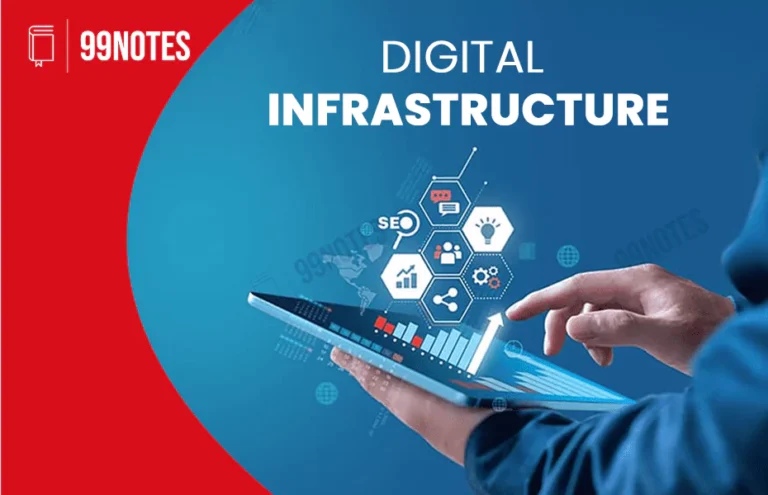Logistics Sector in India & National Logistics Policy- Complete Notes for UPSC
Logistics Sector in India
Logistics refers to the overall process of acquiring, storing and transporting resources from their source to the destination. Logistic management refers to effectively managing all activities such as packaging, warehousing, transportation, inventory management, customs, tracking and tracing of packages, etc.
The logistics sector acts as a lifeline for development in the country. Lower logistic costs and better integration of logistic services reduce the cost of doing business.
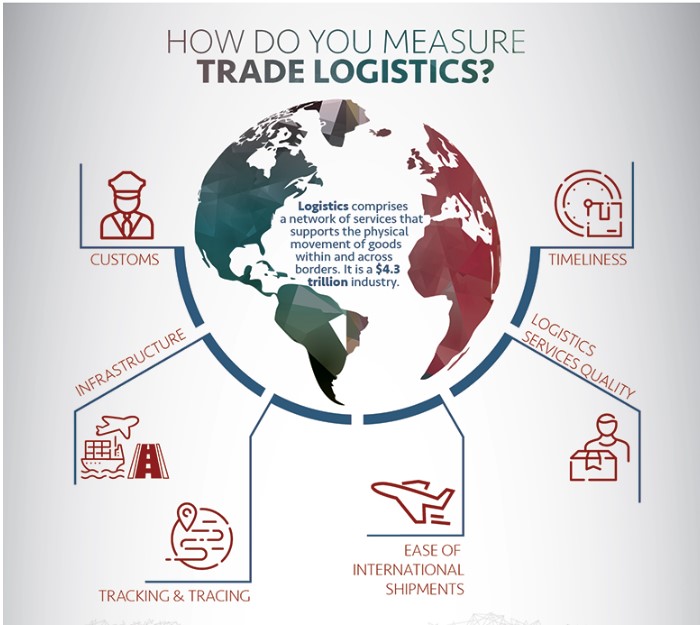
Recently, several initiatives have been taken by the Government to improve the logistic performance across the country. Since independence logistic performance of India has been dismal, but the scenario is changing gradually with the concerned and targeted efforts of central and state governments.
As per the Logistic Performance Index, 2018 (latest) by World Bank, India is ranked 44th out of 160 nations.
Significance of Logistics Sector to Economy:
- India’s logistics sector contributes around 4% to the GDP.
- As per the economic survey 2020, the Indian logistics sector is valued at 15.1 Lakh Crore. (US$ 190 Billion).
- As per the economic survey-2018, more than 22 million people rely on the logistics sector for their earnings.
- Improvement in the logistics sector can potentially reduce 10% of production cost – helping to increase exports by 5 to 8%.
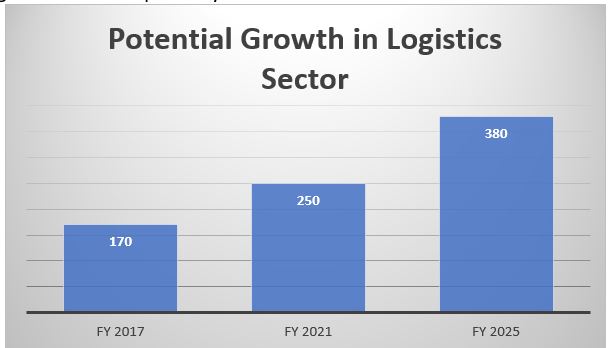
- The logistics sector has its spillover effect in the betterment of MSMEs, improving export competitiveness, and it also helps in stimulating growth in real estate, industrial, services and manufacturing sectors.
Issues with the Logistics Sector in India:
- Higher logistic costs: The average logistic cost for GDP in India is about 14%. The same for BRICS countries is at 11%, and for many developed nations, it is around 7 to 8%. This higher logistic cost acts as a burden on the ease of doing business in India.
- Complicated tax regime: Multiple taxes by the Central and state governments at various stages of logistics lead to significant loss of time and complicate the process.
- Technological backwardness: In many developed economies, logistic management is done through automation. This reduces significant time in paperwork and manual clearances. However, such automation is at a nascent stage in India.
- Fragmentation of the sector: The logistics sector in India needs to be more cohesive. Lack of integration among roads, rail, ports, and water transport leads to further difficulties in transporting goods at competitive prices.
- Lopsided Multimodal mix: In India, nearly 60% of cargo is moved by roads. At the same time, the waterways and railways account for 5% and 32%, respectively.
- Lack of Allied Infrastructure: inadequate warehousing and storage facilities, fragmented supply chain management.
- Hefty and government regulations: Carriers face significant compliance regulations imposed by State Governments and local authorities. It causes time overruns and disruption in supply chains.
- Rising fuel prices: increasing fuel prices for some time acting as a detriment to the logistic sector. These rising fuel prices reduce the profitability of the logistics sector in the long run.
- Lack of standardization: Due to the absence of a single apex body to regulate and set standards for the logistics sector.
- Issues with the port sector: Around 90% of India’s international trade by volume and about 79% by value are carried through ports. Despite this, the development of the ports sector is highly skewed in India.
- Disintegrated Regulation: India’s logistics sector is highly defragmented and complex, with more than 20 government agencies, 40 partnering government agencies (PGAs), 37 export promotion councils and 500 certifications.
- Higher cost of freight transportation as compared to passenger transport in railways.
- Lack of maintenance of national/state highways: leading to significant time delays and accidental losses.
Initiatives Taken by The Government for Improvement of the Logistic Sector:
- Reduction of logistic cost is the highest priority for the Government for holistic development of the logistic sector in India.
- Logistics Master Plan: This initiative of the Government seeks to adopt a geographical approach rather than the industry approach. Through this, several projects and ongoing activities will be integrated to develop a multimodal transport system across the country.
- National Logistics Workforce Strategy: to fulfil the demands of the logistics sector through the holistic development of a skilled workforce.
- National Multimodal Facilities and Warehousing: In order to promote multimodal logistics parks (MMLPs) as a separate class of infrastructure, a National grid of logistic parks and terminals are being planned.
- PM Gati Shakti Scheme: For holistic planning of the multimodal transport ecosystem, the Government has launched the PM Gati Shakti programme with a transformative approach. It will act as an umbrella platform for all infrastructure projects of various ministries/states. It will serve as a single point of management, improving the collaboration and efficiency of implementing these projects.
- The Government has launched National Infrastructure Pipeline with an outlay of 111 Lakh Crore for capital investment in infrastructure.
- The Centre has also launched National Monetisation Pipeline with an estimated potential of 6 lakh crores. The Centre has planned to use these funds mainly for road and port development.
- Adoption of RFID tags at ports and toll, e-Customs initiative seeks to reduce paperwork and time wastage in transportation.
- Further, the Government has undertaken Sagarmala, Bharatmala, and ParvatMala for integrated development of the transportation sector.
- The Government is also planning to set up multimodal logistic parks (35 multimodal logistic parks), dedicated freight corridors and logistic parks at various strategic locations across the country for the seamless movement of goods and manufactured products.
National Logistics Policy (NLP) 2022
To boost the ease of doing business and enhance the livability quotient, the Government launched national logistics policy in 2022. The NLP 2022 is sought as a comprehensive effort towards addressing the cost and inefficiencies in the logistics sector.
Objectives of National Logistics Policy 2022:
-
- The NLP seeks to reduce logistic costs in India by 5% of the GDP. i.e. reduction from 14–15% to 8–9% in the next five years.
- It also seeks to improve India’s ranking in Logistic Performance Index in order to enhance the competitiveness of India’s logistics sector with developed economies.
- It focuses on interdisciplinary, cross-sectoral and multi-jurisdictional frameworks for developing the entire logistic ecosystem.
- The overall goal of the policy is to make the logistics industry more efficient and lowering costs.
- This will help boost economic growth, generate employment opportunities, and make Indian products more competitive in the global market.
Four significant steps involved in NLP:
-
- Integration of Digital Systems (IDS)
- Unified Logistic Interface Platform (ULIF)
- Ease of Logistics (ELOG)
- System Improvement Group: to monitor logistic-related projects regularly.
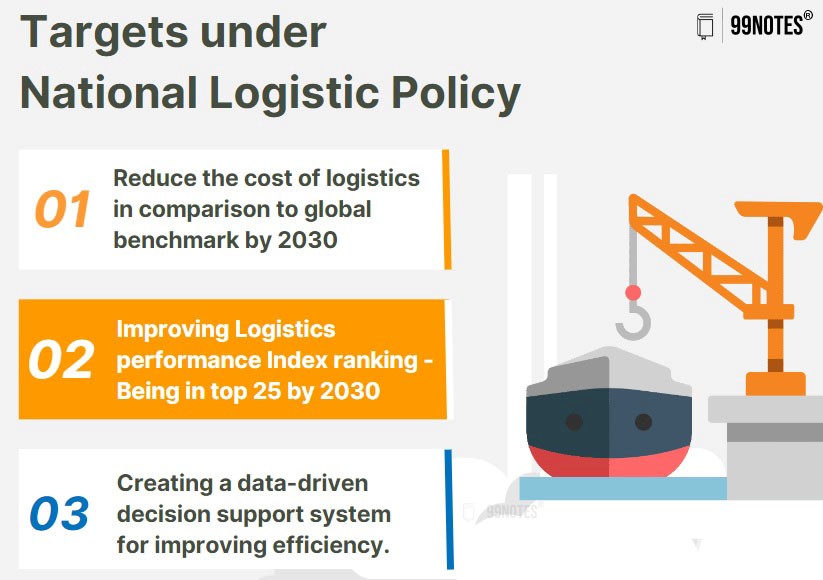
Logistics Performance Index (LPI)
LPI is released by World Bank biennially as part of its report based on a worldwide survey of stakeholders.
- India Ranked 44 in 2018, down from 35 in 2016; However, since 2018, no new LPI rankings have been published by World Bank.
LPI index measures countries across six components (on scores ranging from 1 to 5) —
-
- Customs,
- Infrastructure,
- International shipments,
- Logistics quality and competence,
- Tracking and tracing, and
- timeliness.
- It is an interactive benchmarking tool that helps countries to identify challenges and opportunities in trade logistics and also to improve their performance.
- It is based on the feedback from the ground on the logistics friendliness of the countries.
- The Government has also launched LEADS Index on the lines of the Logistics Performance Index. This index seeks to gauge the logistic ecosystem in Indian states.
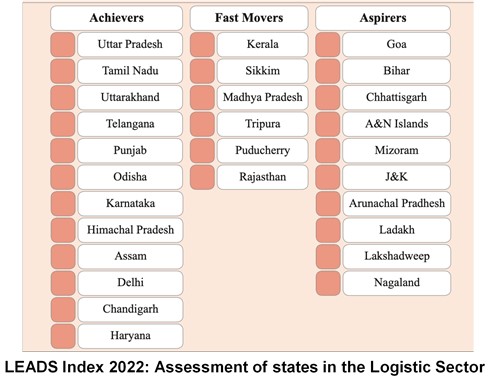
Source: Economic Survey 2022-23
Way Forward
Even though the Government is committed to the improvement of logistics through projects as mentioned earlier/schemes, the following steps need to be taken for further improvement:
-
- Developing more resilient and efficient supply chains.
- Promotion of standardization, digitization and automation for the reduction of manual delays
- Ensuring proper integration of transportation means such as roads, rails, ports, and air transportation.
- Better coordination across the regulatory agencies: to reduce the existing bottlenecks in transporting goods across and outside the country.
- Improvements and allied facilities: subsidies and credit lines can be given for developing warehouses and storage facilities as their vital in the logistics sector’s performance.
- Optimum uses of available capacity of inland waterways: inland waterways are one of the most efficient, cost-effective and environmentally friendly means of transportation. However, it needs to be more utilized and developed in our country.
- Technology-driven approach: this can reduce documentation requirements and transit delays; on the other hand, it can improve inventory management and tracking and tracing of packages.
Conclusion
The announcement of NLP and other projects, such as the national monetization pipeline, national infrastructure pipeline, and PM Gati Shakti, provide a much-needed boost for the development of the logistics sector. With capital investment increasing in the Indian economy in recent times, improving the logistics sector can help realize the dream of making India a US$ 5 trillion economy.



![What Is Social Infrastructure: Meaning, Importance &Amp; Challenges [Upsc Notes] | Updated December 4, 2025 What Is Social Infrastructure: Meaning, Importance & Challenges [Upsc Notes]](https://www.99notes.in/wp-content/uploads/2023/05/social-infrastructure-99notes-upsc-1-768x512.webp)
